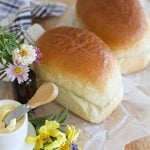Favorite Soft Sandwich Bread
This homemade sandwich bread recipe is perfect for anyone looking to bake soft, sturdy loaves right at home. Made with simple ingredients like active dry yeast, all-purpose flour, and olive oil, this bread holds together beautifully—ideal for sandwiches that won’t fall apart.
Servings: 2 loaves
Calories: 1897kcal
Ingredients
- 2 tablespoons active dry yeast or instant yeast
- ½ cup warm water 110°F
- 3 Tablespoons sugar
- 2 cups additional warm water
- 2 ½ teaspoons salt
- ⅓ cup high-quality olive oil or avocado oil
- 6 ½ cups all-purpose flour or bread flour adjust as needed
Instructions
- Activate the Yeast:
Begin by dissolving the active dry yeast in ½ cup warm water and the 3 tablespoon sugar. Let the yeast mixture sit for 10-15 minutes until it becomes foamy, showing that your yeast is alive and ready to make the dough rise. - Prepare the Dough:
After the yeast mixture is foamy, add 2 cups of warm water (hot water will kill the yeast), salt, and olive oil. Slowly mix in 6 ½ cups of flour, one cup of flour at a time, until the dough begins to clean the sides of the bowl. Depending on your kitchen environment, you may need to add a little more or a little less flour.Tip for the best results: Keep a kitchen scale handy for more precise flour measurements, especially if using different types of flour like bread flour or whole wheat flour. - Knead the Dough:
Knead the bread dough in the bowl of your stand mixer using the dough hook attachment on low speed for about 3 minutes. The dough should be soft, elastic, and not too sticky. - First Rise:
Place the dough in a large bowl that’s been lightly greased with olive oil. Cover the top of the dough with plastic wrap or a damp kitchen towel and let it rest in a warm place for 45 minutes or until it has doubled in size. - Shape the Loaves:
After the first rise, punch the dough down and turn it out onto a lightly floured surface or work surface. Divide the dough into two equal portions. Flatten each portion into a rectangle, roll it up tightly, and pinch the edges to seal. Place each loaf into a bread pan lined with parchment paper. - Second Rise:
Let the loaves rise again for 30 minutes. Meanwhile, preheat your oven to 375°F (190°C). This second rise helps give the bread a light, fluffy texture without collapsing during baking. - Bake:
Bake the loaves for 30 minutes, or until the tops are golden brown and the internal temperature of the bread reaches 190°F. Let the loaves cool for 5-10 minutes in the bread pan, then transfer them to a wire rack or cooling rack to cool completely.
Notes
Storing the Bread:
For the best results, let the loaves sit at room temperature for 12 hours before storing them in an airtight container or plastic bag. You can keep one loaf in the bread box and store the second in the freezer for the next day or week Use warm—not hot—water: Water that’s too hot can kill your yeast. Aim for about 110°F for the perfect rise. Adjust flour as needed: Humidity affects dough. Add flour just until the dough pulls cleanly from the bowl and feels soft and slightly tacky, not sticky. Brush with butter: For that classic soft, golden crust, brush melted butter over the loaves right after baking.
For the best results, let the loaves sit at room temperature for 12 hours before storing them in an airtight container or plastic bag. You can keep one loaf in the bread box and store the second in the freezer for the next day or week Use warm—not hot—water: Water that’s too hot can kill your yeast. Aim for about 110°F for the perfect rise. Adjust flour as needed: Humidity affects dough. Add flour just until the dough pulls cleanly from the bowl and feels soft and slightly tacky, not sticky. Brush with butter: For that classic soft, golden crust, brush melted butter over the loaves right after baking.
Nutrition
Serving: 1g | Calories: 1897kcal | Carbohydrates: 330g | Protein: 47g | Fat: 40g | Saturated Fat: 6g | Polyunsaturated Fat: 6g | Monounsaturated Fat: 27g | Cholesterol: 9mg | Sodium: 459mg | Potassium: 564mg | Fiber: 12g | Sugar: 19g | Vitamin A: 17IU | Vitamin C: 0.2mg | Calcium: 81mg | Iron: 19mg
